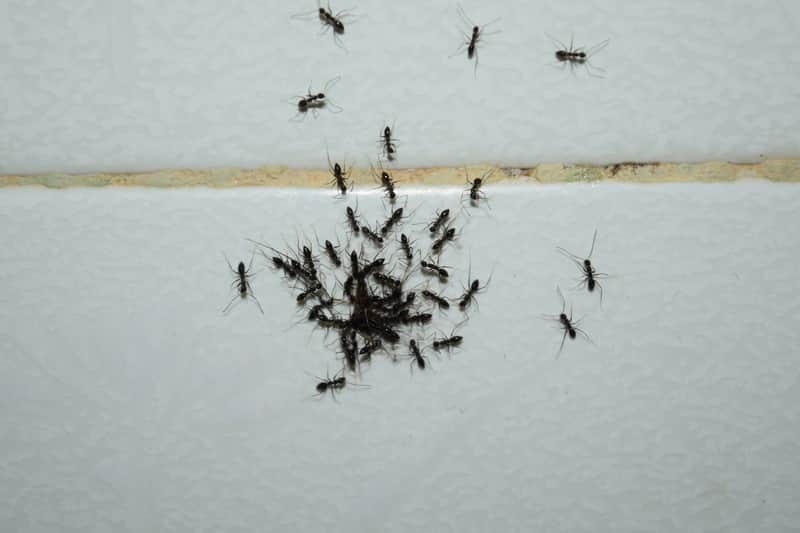Ants are common insects found in the home, including the bathroom. Although carpenter ants may be the culprits, other ant species, such as Pharaoh, Argentine, odorous house and pavement ants, may also be at fault.

Ants enter homes in search of food, water and shelter. Many species may be attracted to the moist environment of your bathroom. Carpenter ants, for instance, create their nests in damp, rotting wood. Inside of bathrooms, these ants may be found in rotting window ledges and other areas where moisture collects. Throughout the home, ants can enter via:
- Cracks and crevices around windows and in foundation walls
- Through heating or air conditioning ducts
- Through ventilation openings in attics
- Wherever tree branches, shrubs or utility lines make contact with the structure
Where Do Flying Ants Come From?
Flying ants are not an anomaly. Also known as alates, flying ants are reproductives who are ready to mate. Their wings allow them to leave their colony to begin their search for a mate. This is commonly referred to as swarming because many ants begin this “nuptial flight” at the same time. Although many ant species reproduce in the spring and summer when the conditions are typically right, swarming ants may also be active during other times of the year. With proper access from the outside, it's possible to see these flying ants in your bathroom. However, it's important to know the difference between flying ants and termites so that you don't misidentify the pest you're dealing with. A pest control professional can help with identification.
Ant Prevention
Depending on the species of ant that you've noticed in your bathroom, the nest that the ants are coming from could be inside a wooden beam or other construction component in your home, underneath the flooring or behind your walls. And that may just be a satellite nest. The parent colony nest could be further away outside. Eliminating entry points, controlling ants (which can reduce ant hills in your yard) and having a professional repair any plumbing leaks on your property can help in preventing ant infestations in your home.
Outdoors, you may find ants, such as carpenter ants, living in moist wood, including rotting trees, tree roots and stumps, and logs or boards lying on or buried in the ground. Carpenter ants are not usually considered to be a nuisance until they begin to nest and forage for food in homes. At that point, carpenter ants can cause significant structural damage as they begin excavating and tunneling through wooden elements in your home to build their nests.
Taking these preventive measures can help reduce the likelihood of a carpenter ant infestation in your home:
- Have moisture problems corrected, such as leaking faucets, roof leaks and water drainage issues.
- Replace termite-damaged or water-damaged wood. Usually, carpenter ants will not infest wood that has a moisture content of less than 15 percent.
- Ensure proper clearance between soil/mulch and structural wood.
- Provide good ventilation under the house and in the attic.
- Remove logs, stumps and other wood debris from areas surrounding your home. Also, store firewood away from the house and off the ground.
- Trim shrubs and trees that touch your house.
- Seal all outside cracks and crevices, as well as holes through which pipes and wires enter your home.
- Ensure your window and door frames are properly sealed
How to Help Get Rid of Ants
Prevention is key, but if you’re in the middle of battling a serious ant infestation, or you want the help of a professional from the start, consider calling Terminix®. Our technicians will implement an ant control solution using the latest equipment and techniques to help remove ant infestations and keep them from coming back. Contact Terminix today. Get started today and save $50¹ on a pest control plan².




